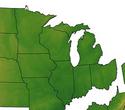Things are looking better in St. Louis. For decades, St. Louis has been one of the slowest-growing metropolitan areas of the United States. Its historical core city has lost more than 60 percent of its population since 1950, a greater loss than any other major core municipality in the modern era. Nonetheless, the metropolitan area, including the city, added nearly 50 percent to its population from 1950. The fate of St. Louis has been similar to that of Rust Belt metropolitan areas in the Midwest and East, as the nation has moved steadily West and South since World War II (Note). read more »
Urban Issues
Commuting in New York City, 2000-2010
New York City is infamous for congestion and long commutes. At 34.6 minutes, it has the longest average commute time in the United State. The region is also America's top user of public transportation, with 30.7% of all metro area commutes made by transit. Nearly 40% of all transit commuters in the United States are in the metro New York. As transit commutes generally take longer than driving, one might be tempted to link these facts. But commute times also seem to correlate with city size, and bedevil big cities with limited public transit too. read more »
Clues from the Past: The Midwest as an Aspirational Region
This piece is an except from a new report on the Great Lakes Region for the Sagamore Institue. Download the pdf version for the full report including charts and maps on the region.
The American Great Lakes region has long been a region defined by the forces of production, both agricultural and industrial. From the 1840s on, the region forged a legacy of productive power, easily surpassing the old northeast as the primary center of American industrial and agricultural might. read more »
The Evolving Urban Form: Moscow's Auto-Oriented Expansion
Moscow is bursting at the seams. The core city covers more than 420 square miles (1,090 kilometers), and has a population of approximately 11.5 million people. With 27,300 residents per square mile (10,500 per square kilometer), Moscow is one percent more dense than the city of New York, though Moscow covers 30 percent more land. The 23 ward area of Tokyo (see Note) is at least a third more dense, though Moscow's land area is at least half again as large as Tokyo. read more »
Unintended Consequences of the Neo-Traditional City Planning Model
Since the early 20th century, the almost universal adoption of the automobile by US residents has had a profound impact on how we plan and design communities. The widespread use of the auto not only spurred development outside of traditional urban centers, it minimized the need to blend multiple land uses into compact areas. read more »
Orléans, Ontario: A Franco-Ontarian Suburb
In a mere forty years Orléans has gone from an overwhelmingly French-speaking village to a suburb of Ottawa where scarcely one-third of the population has French as its mother tongue. Nonetheless, the French presence remains vibrant and local francophones are exceptionally dedicated to preserving their language and culture and building on their achievements. No other place in Ontario boasts cultural programs and facilities like those that serve Orléans’ francophone community. read more »
- Login to post comments
Local Chambers of Commerce: Not Born for Ourselves Alone
Most people are more interested in organized crime than in organized business. Chambers of commerce do not often attract headlines except for the occasional, inevitable dustup with a public authority. For that reason, this April’s 100 year anniversary of the founding of the U.S. Chamber of Commerce may pass without much public attention. This would be a shame, as groups of companies have left their fingerprints all over the American civic landscape, and were busy even at the birth of Tom Donohue’s organization in 1912. read more »
Arlington and Shenzhen: A Tale of Two Cities
Seven thousand miles separate Arlington, Virginia and Shenzhen, China. Two continents apart, these two cities could not be more different. Yet they are similar, geopolitically and globally. The characteristics of today’s globalization have united and connected cities like Arlington and Shenzhen. read more »
- Login to post comments
Why Downtowns Fail and How They Can Come Back
To many Florida developers in the last decade, downtown condo towers seemed to make a lot of sense. They were sold as the logical locale for active seniors and millennials, great affordable starter homes, and best of all, investments. Reinvigorating downtowns became fashionable currency in many of Florida’s second and third tier cities. read more »
Special Report: Census 2011: Urban Dispersion in Canada
Canada now has fastest-growing population in the G-8 (Note 1), according to the results of the 2011 census, released last week. Canada's growth rate from 2006 to 2011 exceeded that of the United States by nearly one-third and is nearly one half greater than just a decade ago. The population rose from 31.6 million in 2006 to 33.5 million in 2011. read more »





















